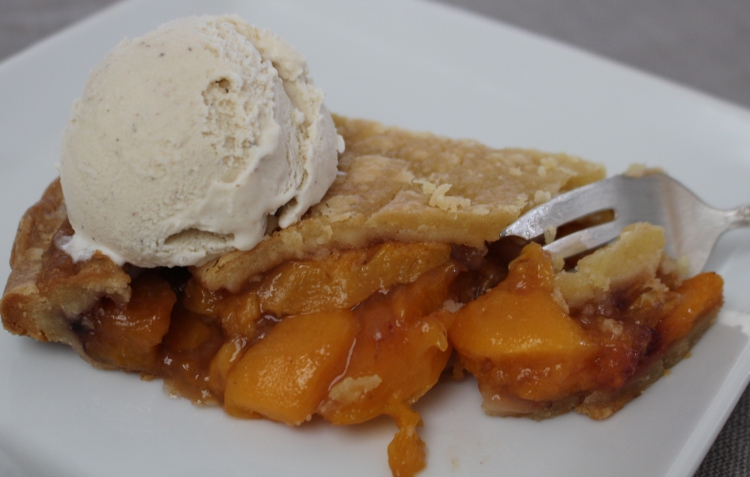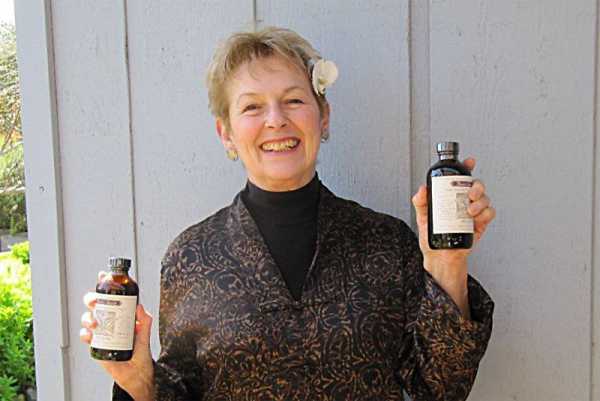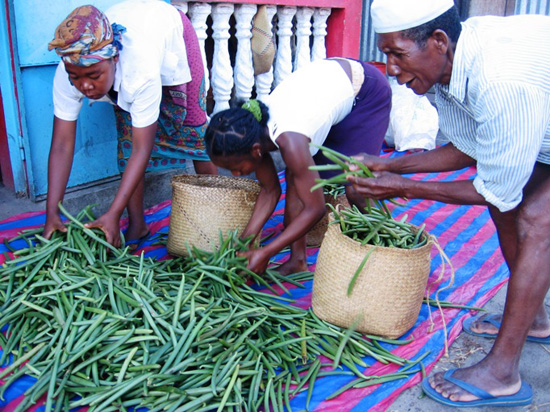
I'm amazed at how superior your vanilla is!
– Des, The Grommet
Courtesy of Courtenay Dunk: www.spicelines.com
For just a moment, for no reason I can decipher, I am in a place I know better than I should; I fall through the gratings of the conscious mind and into a place that observes a different kind of logic.
–Pico Iyer, Sun After Dark: Flights into the Foreign
Tall palms cloaked in heart-shaped leaves. Pepper vines dangling heavy clusters of green, unripe fruit.
Vaguely Indonesian houses, bright blue, burnt orange, pale pink stucco. Tip-tilted red tile roofs topped with bulbous finials pointing skyward.
A woman, head held high, striding along the edge of the road, ignoring the bleating motorbikes that sweep past her. Next, a sign for the Damsel Motor Driving School.
Then this:
An elephant sits regally in the back of a truck as he is chauffeured to work.
And this:
In a glass coffin on a verandah, a man with a grey-streaked beard, hands folded, dressed in white. Men gather under a blue tarp, filling rows of metal folding chairs. At the outer gate, a poster-sized black and white photo of a young man: plump cheeks, dark beard, black robe and turban. A voice blares over a loudspeaker.
I am in a place I know better than I should, said Pico Iyer. It is new and it is strange but I know it. Not well, but well enough.
We are inching up a narrow, traffic-clogged road somewhere north of Kochi, on our way to visit two small spice farms. Swollen streams cut through groves of palms smothered in pepper vines. There are spiky-leaved turmeric plants, some tapioca. A mill yard is stacked with sawn trunks of jackfruit trees. Clusters of golden bananas dangle from roadside stands.
For years I’ve had a burning obsession to go to India. One of my top 1,001 reasons is to see peppercorns and other spices growing in their native habitat. Yet now that I’m here, there’s no epiphany, just matter-of-fact glimpses of life in a small town that happens to be halfway around the globe.
But as Iyer said, sometimes you fall through the grating.
We stop first at a homestead where Jacob, a farmer, and his family grow spices to sell. Walking up a hill to the modest stucco house, we pass through a forest of widely spaced rubber trees. The trunks are deeply gashed; squares of plastic sheeting act as band aids to stanch the flow of sap.
A brown and white goat, tethered to one tree, sits peacefully on the ground.
In the yard outside the house, a few kilos of peppercorns are spread on a white sack to dry in the baking sun. Three middle-aged men, representatives from the Indian Spices Board, step forward. “In Kerala, there are very few large plantations. Everything is grown by small farmers who harvest and sell in the market,” one intones. “This pepper is Mg1—it’s an average grade. The farmers just grow small amounts. They can’t compete with Vietnam which is producing 100,000 tons annually.”
I ask about the premium, sun-ripened peppercorns grown on the Wynad plateau that command super high prices at places like Dean and DeLuca. “Oh, yes,” says the spice man, a touch dismissively. “That pepper is produced in the forest under the trees. It has the most natural pepper flavor.”
Liju, Jacob’s son, is a semi-conductor engineer. A tall soft-spoken boy in his twenties, wearing horn rimmed glasses and a plaid shirt, he has recently quit his job. What’s next? “I want to move to the city, to Kochi, one and a half hours away.” In the meantime he’s on the farm, eager to show the spices his family grows.

In a spice garden, green, unripe pepper berries dangle in
clusters from vines that clamber up the trunks of palms.
Pepper vines are everywhere, shrouding the smooth trunks of the palms. Liju plucks a long cluster of berries, dangling just within reach. Some are shriveled black, some are still green, others are ripening to red, all on the same stem.
“Vanilla,” he says, pointing to vines with fleshy stems and leaves hanging on small trees with skinny trunks. A solitary greenish orchid has opened its petals wide. “If the flower is pollinated, the bloom will dry and it will develop into a bean,” he explains as he presses the pollen-bearing anthers onto the stigma using a tiny stick.

Using a tiny stick, Liju pollinates a vanilla orchid just as it has
been done for centuries in Mexico where vanilla was born.
This is hand pollination, the only way to assure the production of vanilla beans. It is identical to the way it is done by the Totonac Indians in Veracruz, thousands of miles away in the land where vanilla was born. How much does Liju’s family harvest? “Forty to 50 kilos a year.”
There are a few nutmeg trees, but the round green fruit, still immature, seems to be rotting where it hangs. “This is no good,” says Liju, pulling a spotted fruit off the tree. He cuts it open, then tosses it away.
Almost more than pepper, I have longed to see nutmeg growing on the tree. With the brilliant red mace clinging to the shiny brown nut, it is the most beautiful of spices, and, once, the most expensive. In the 16th century, a pound of nutmeg brought a 3,200 percent profit by the time it reached England. Ultimately, lust for nutmeg and other spices grown only in Indonesia led to the brutal subjugation of the archipelago by the Dutch. Now nutmeg is grown in Grenada and India, and you can buy an ounce for $2.49.
But what about green nutmegs? In India and Malaysia, pickled unripe nutmegs are a delicacy sometimes found in the markets. As well, in an addendum to an 1805 British edition of the Periplus Maris Erythraei, an ancient Greek mariner’s guide to the waters of the Indian Ocean, the author writes: “…the unripe nutmeg is sometimes pressed, and an aromatic liquid procured, fragrant in the highest degree, which perhaps may have some relation to perfumed unguents of the ancients.”
The more I look, the more I see that this spice garden is really a near-primeval jungle of trees, vines and low plants, all growing harmoniously together. It is organic because Jacob will not, or perhaps cannot, use costly pesticides. It feels fragile, on the brink of change. Just five or six years ago, vanilla beans commanded high prices, and before that, peppercorns. Now rubber trees yield more income than spice. Who will carry on?

In the nursery at Josy’s farm, new strains of nutmeg are being grafted
onto older rootstock. But rubber is easier to grow and more profitable than
traditional spice crops.
About an hour away, at another spice farm near Muvathapuzha, we see more rubber trees. This is a larger, more prosperous plantation and as we walk up the driveway to the sprawling house, we pass by beds of beautiful flowering plants: starry white medicinal jasmine, fragrant Chinese orange, young guava trees. On the back verandah we are offered fresh pineapple juice, moist carrot cake and salty banana chips fried in coconut oil.
Behind us there is an elementary school. The children squeal with delight as they wave to the Americans over the back wall.
Josy, who owns the farm, is a handsome, 30-something man whose family has been growing spices for 150 years. As we stroll through the grounds, I see pepper, vanilla and turmeric. He cuts a strip of fragrant bark from a lone cinnamon tree for us to smell. But here again, rubber has become a principal crop. “It is easier to grow and brings more money,” he says.

A farm worker scrambles up a nutmeg tree laden with ripe fruit and, using a
curved blade, cuts down several nutmegs the size of nectarines.
But then my heart flutters, just a little. We have come to a magnificent grove of nutmeg trees. They are 30 years old, as many feet high, and laden with unblemished yellowish fruit the size of small nectarines. A barefoot farm worker scrambles up a tree and pulls a curved knife from his waistband. There is a wild thrashing among the leaves as he hacks at a few ripe nutmegs which tumble to the ground.

A fresh nutmeg opens to reveal the bright scarlet mace which turns dull gold
when dried. The mace clings to a shiny brown shell that contains the kernel
we know as nutmeg. The flesh of the fruit smells faintly of the dried spice.
Another worker slices a nutmeg with his knife. The halves of the golden shell split open to reveal a shiny purplish brown nut enmeshed in a bright scarlet aril that resembles thick red filigree. This is mace, which, when dried, fades to a dull gold. The nutmeg itself is hidden within the shiny brown shell. It’s like a series of Chinese puzzle boxes, each of which must be opened before you get to the treasure.

After a lunch of spicy mutton stew, Josy’s wife Pavizham shows us how to make
appams, slightly sweet, slightly sour pancakes made of fermented rice batter.
Later Josy’s wife Pavizham shows us how to make appams, or rice hoppers. These are thin pancakes with puffy centers, made of a fermented batter of rice flour, coconut milk, yeast, sugar and salt. They are tangy and a little sweet. We eat them with a richly seasoned mutton stew, fiery with green chillies, fragrant with spices, many of them from the garden. For me, this would be the ultimate joy: Spices growing outside the kitchen door, as easy to pluck as my own garlic chives and purple basil.
In the bus, lurching back to Kochi, we pass the house with the blue tarp. The glass coffin is empty, the house seemingly deserted.
Posted by SpiceLines on September 15, 2008 7:52 AM | Permalink
I was given a small bottle of Rain’s Choice in a gift basket and I have been hooked ever since. The flavor makes all of my baking so much better! I will never use grocery store vanilla again!


© 2021. All Rights Reserved
Designed/Developed by Kat & Mouse